Germany Bundesliga
Bundesliga: How Does Each Team Play?

[ad_1]
theanalyst.com
You might have your own ideas about how each Bundesliga team plays football this season, but what does the data say?
When looking at the team styles of all Bundesliga teams, Arminia Bielefeld are one of the first teams that stand out. They practically ‘break’ the graph below, with their club crest nestled right next to the ‘fast & direct’ label at the top left of the chart.
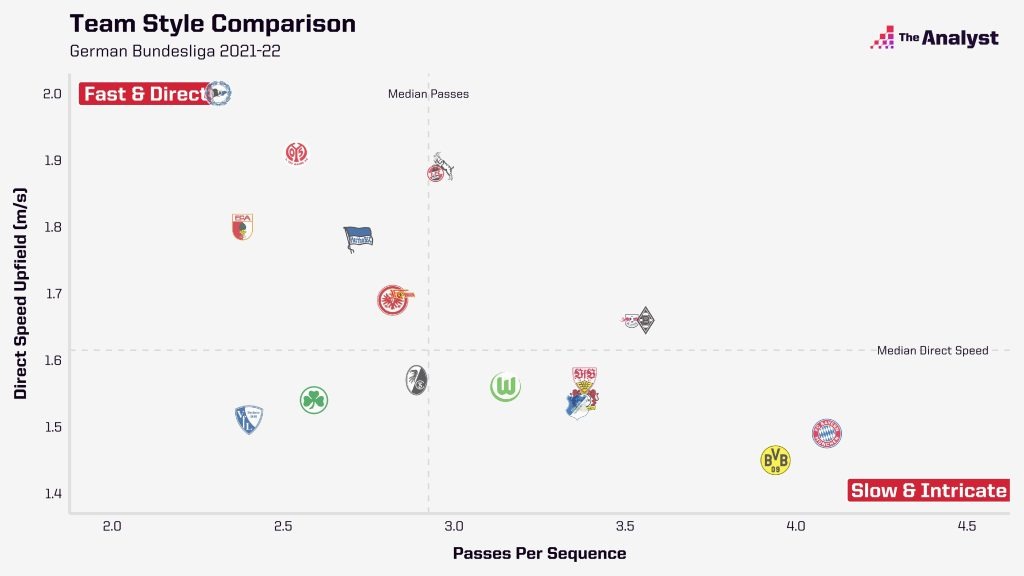
No other team plays as direct as Arminia, progressing the ball upfield at 2.0 m/s, while using so few passes per sequence (2.3 on average). This style of play starts from the back with goalkeeper Stefan Ortega Moreno. He’s played 583 long balls this season, with 280 of those finding a team-mate. Only Bochum’s Manuel Riemann has pumped more long balls (341 out of 726) than him. 215 of Ortega Moreno’s passes were played into the final third of the pitch, showing his desire to go long, with only Köln’s full-back Benno Schmitz playing more (218) out of all players in the league.
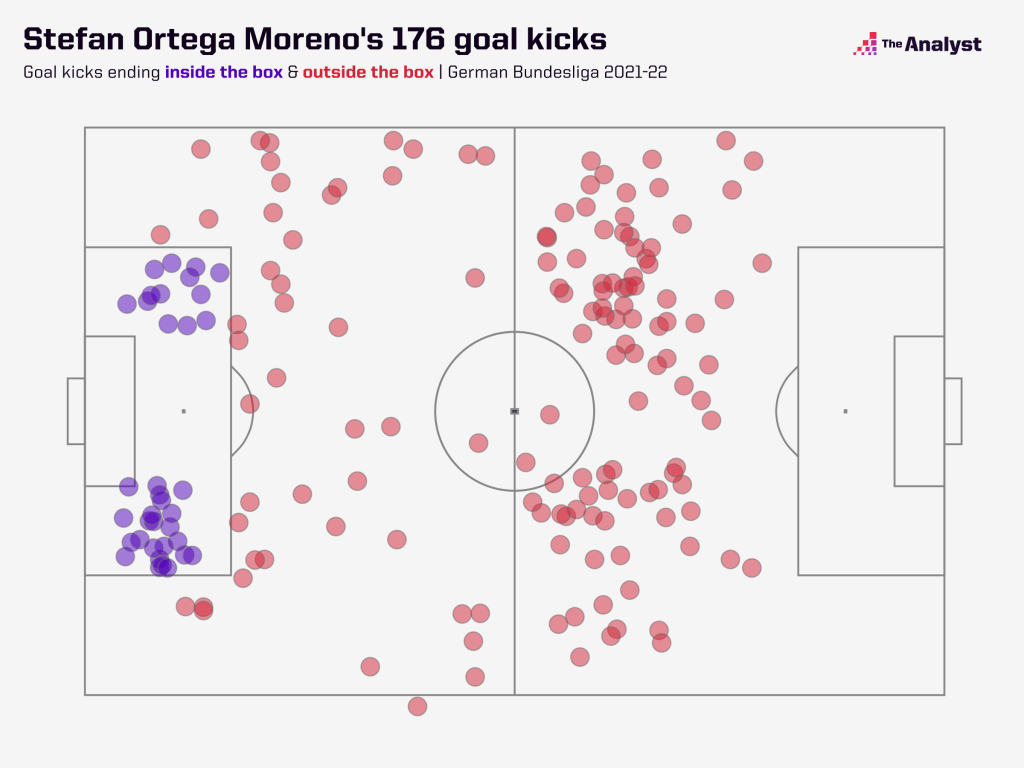
With this approach, it stands to reason that Arminia Bielefeld’s forward players are going to have to contest a lot of balls in the air. Indeed, of all Bundesliga players with at least 450 minutes played this season, no players have contested as many aerials per 90 minutes as DSC forwards Janni Serra (13.6) and Fabian Klos (13.3). With 6.4 aerials won per 90 mins, Klos also leads the league (min. 450 mins).
A contrast to Bielefeld’s style of play is seen in the teams that are ranked first and second in the Bundesliga table. No team in the league progress the ball forward at a slower rate than Borussia Dortmund this season (1.45 m/s). Dortmund play 51% of their passes in their own half and only 31% of their passes forward – only Bayern average a lower percentage of forward passes (30%). Bayern are also the only team that play more passes per sequence (4.05) than Dortmund (3.97). Both teams are all about dominating the ball and staying patient in possession.
However, if you only look at the last six games, another team emerges in this category: RB Leipzig.
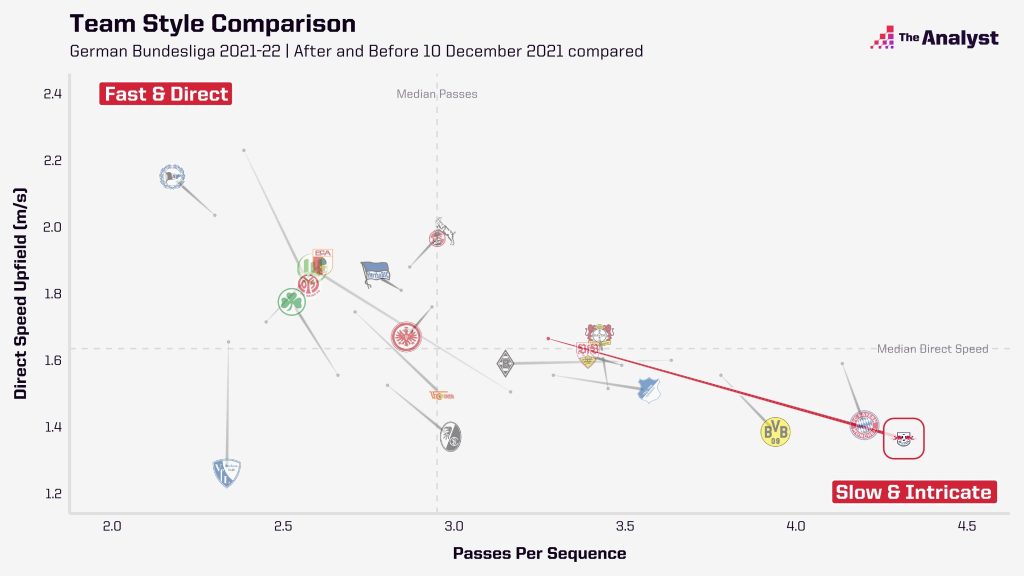
Since Domenico Tedesco took over as RB Leipzig coach from Jesse Marsch on Matchday 15, Leipzig’s playing style has changed significantly.
While RB played in a much more direct style under their former coach (36% of passes played forwards), the Saxons now focus on control and staying patient in possession until a gap opens up in the opposition defence. They play just 30% of their passes forward. In Tedesco’s six games so far, Leipzig have averaged 615 passes per game, over 100 more (499) than in the previous 14 league games this season. Furthermore, they’re average 18 sequences involving 10+ passes per game under the German-Italian coach, twice the number as under Marsch.
Since the change in the dugout, Leipzig’s 4.3 passes per sequence are the most in the league in this period, while only Bayern (29%) played a lower proportion of their passes forward than RB (30%).
Out of possession, Leipzig do not go after their opponents as aggressively under Tedesco as they did under Marsch. In their first 14 games of the campaign, they averaged 11.4 high turnovers per game, compared to just 9.8 under Tedesco. Despite that, their compact pressing in the middle of the field has improved dramatically, with Leipzig managing to win the ball closer to the opponent’s goal under Tedesco (44.2 metres from their own goal on average, only Mainz 44.3m and Bayern 48.2m win it back higher) than before (44).
After winning the ball, RB can decide whether to secure possession or to quickly spring forward. Since their coaching change, Leipzig have launched 12 direct attacks – open play sequences that start inside the team’s own half and have at least 50% of movement towards the opposition’s goal and ends in a shot or a touch in the opposition box – which is enough for only fifth most in the league. Yet four of them resulted in a goal (33%), with no other side managing more over this time. Only upcoming opponents Bayern have scored as often from direct attacks (4 out of 17) in the Bundesliga.
Leipzig’s new approach has borne fruit, with RB picking up 13 points – 42% of their points total this season – under Tedesco. Only Bayern (15) have won more points since his appointment.
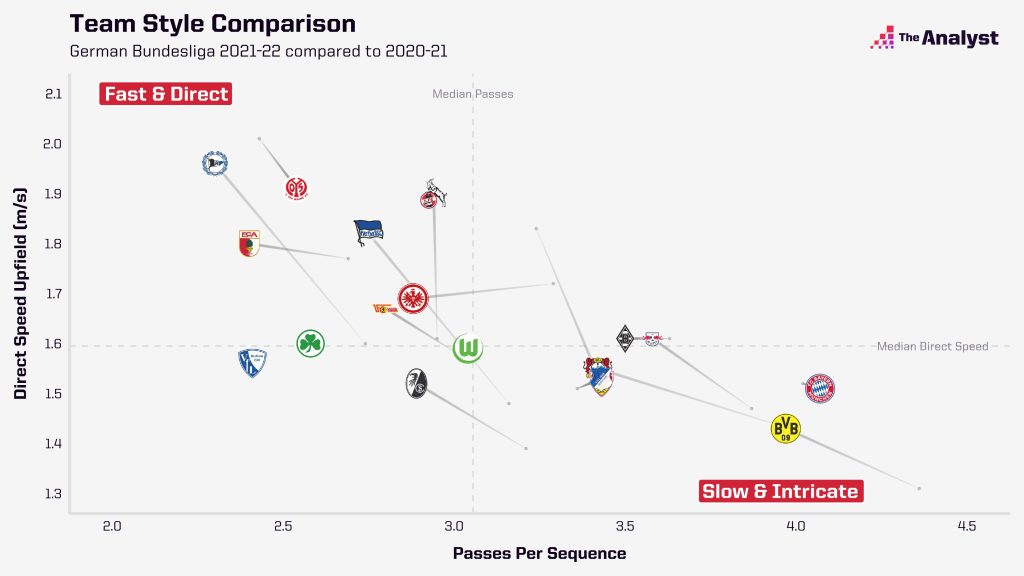
Another team that has not only benefitted from a coaching change but has also experienced a stark change in philosophy is 1. FC Köln. Under Steffen Baumgart, the Cologne side are now playing at a considerably faster pace than last season while their number of passes per sequence have remained constant.
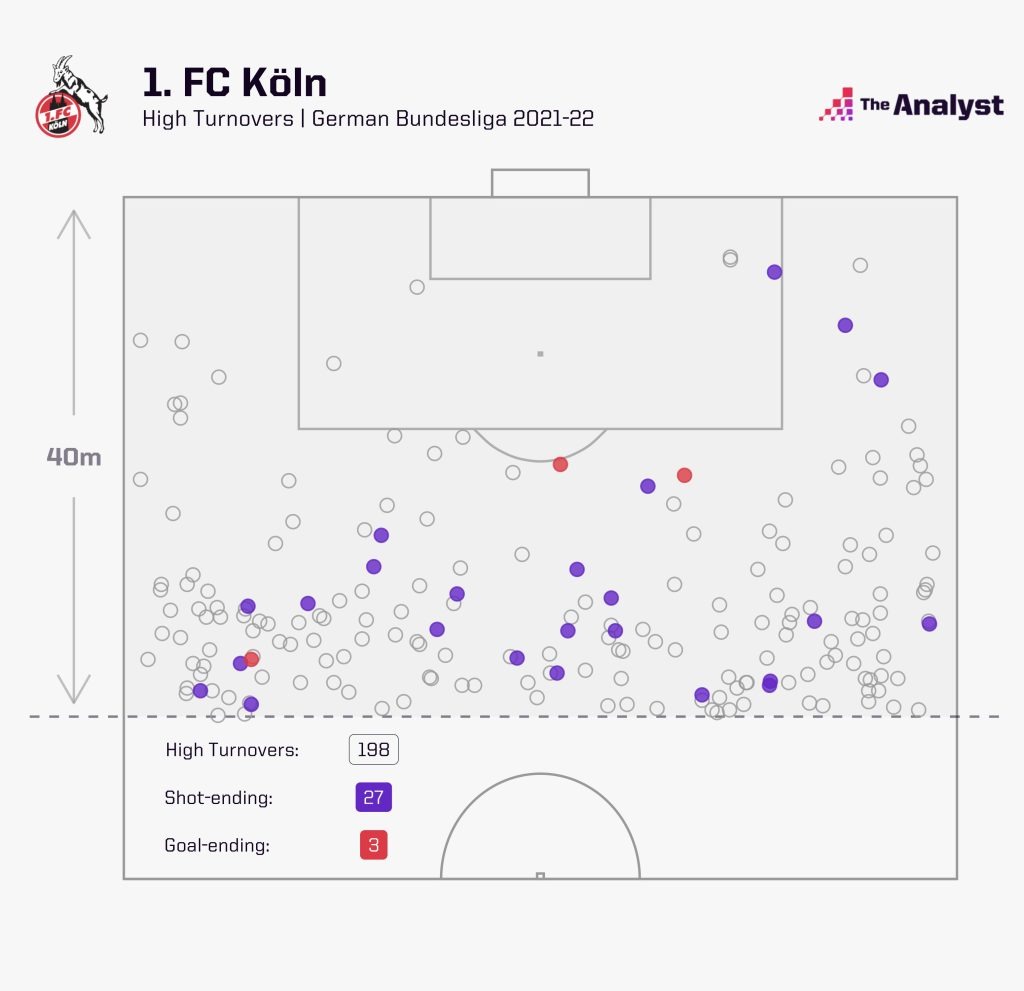
A big area of focus for Köln is pressing. On average they allow the opposition just nine passes before they make a defensive action (PPDA). Compare that to 2020-21, where they had a PPDA of 15 and you can see the difference. Accordingly, Baumgart’s team are starting their attacks 44 metres from their own goal compared to 40.1 metres a season ago, while they have forced the third most high turnovers among all Bundesliga sides (198), a total that is already not far off from their tally last season (223).
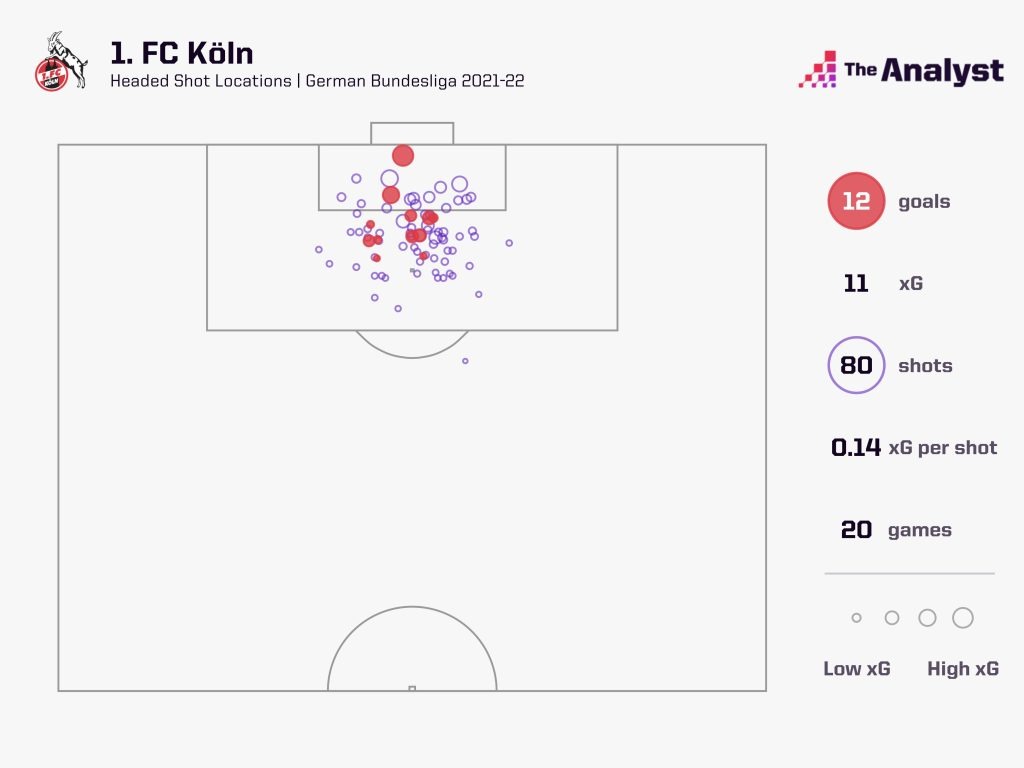
The end result of Köln‘s fast-paced attacks are sharp crosses into the box. They average 18 crosses from open play per game, which result in about four and a half shots per match. In total, these shots from crosses have amounted to 12.1 expected goals as Köln load the box. Steffen Baumgart’s side top the league in each of those three categories.
That crossing game is paired with prolific finishing in the air. None side has fashioned as many headed shots per game as Köln (four), nor has any team created as good scoring opportunities (11 xG from headers).
Köln lead all Bundesliga teams in 2021-22 with 12 headed goals. Central to that effort is Anthony Modeste who has scored nine of Köln’s 12 headed. In fact, Modeste has scored more headed goals on his own than almost every team combined this season. Only SC Freiburg (11) have eclipsed his individual total.
Implementing a philosophy is not the easiest task for a coach, but with the board´s trust anything is possible. Hoffenheim´s manager Sebastian Hoeneß is proving just that.
In his first Bundesliga campaign, his side faltered going forwards. Hoffenheim created just 1.5 build-ups per game (the number of open play sequences with 10+ passes ending in a shot or at least a touch in the opposition’s box), scoring only twice from such attacks. This season however, Hoffenheim are creating two build-up attacks per game and lead the league with five goals following such situations.
Hoeneß has managed to increase the impact of his game plan on the pitch and Hoffenheim are reaping the rewards. They’re average three more touches per game in the opponent’s box compared to last season, as well as an extra shot per match.
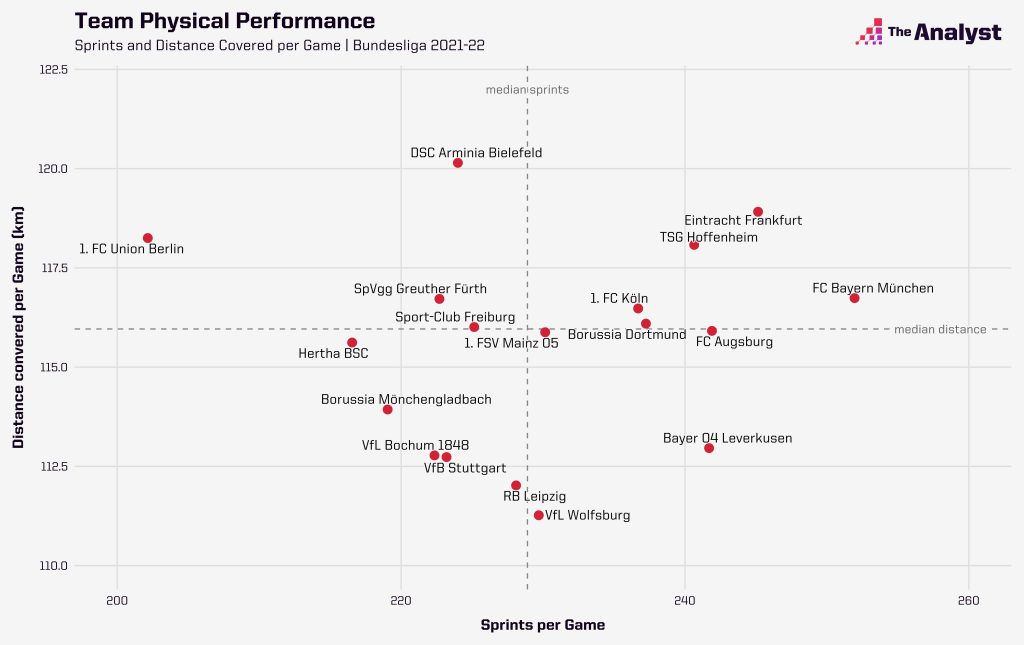
One of only three sides averaging more kilometres per game than Hoffenheim are Union Berlin (118.3). As the above matrix demonstrates, the capital city club are an anomaly. They run by far the fewest sprints per match (202) and have played a league-high 18 games in which they’ve made fewer sprints than their opponents, winning eight of them and losing three (D7). The oldest team in the Bundesliga (just over 29 years old on average) either are unable to, or wisely choosing not to, accelerate unnecessarily.
On the other hand, FC Augsburg are the only team among the top five sprinting sides in the league not to be situated in the top half of the table. Augsburg have made more sprints than their opponents in a league-high 15 matches this season, collecting a respectable average of 1.3 points per game in those matches. However, the problems arise when Augsburg run fewer sprints than their opposition, losing on all five instances.
Another team that jump out are Eintracht Frankfurt. In this season’s Bundesliga, Frankfurt run the second most kilometres per game and the second most sprints per game, a testament to their intensity and durability. Fitness is clearly paying off for them as well, as Frankfurt have scored three goals after the 90th minute resulting in a league-high five points from such goals.
Bayer 04 Leverkusen have enjoyed a successful Bundesliga campaign under new Coach Gerardo Seoane, sitting third in the table ahead of their clash with second-placed Dortmund.
Under the Swiss man, Leverkusen look to draw out their opponents before hitting them on the counter thanks to the lightning speed of players like Jeremie Frimpong (sixth-fastest Bundesliga player) and Mitchel Bakker, the eighth).
This is helped by the Werkself firing on all cylinders at the start of each match. Bayer have scored a league-high 12 goals in the opening 15 minutes of matches. As a result, only Bayern (55%) have spent more time in winning positions than Bayer 04 (50%).
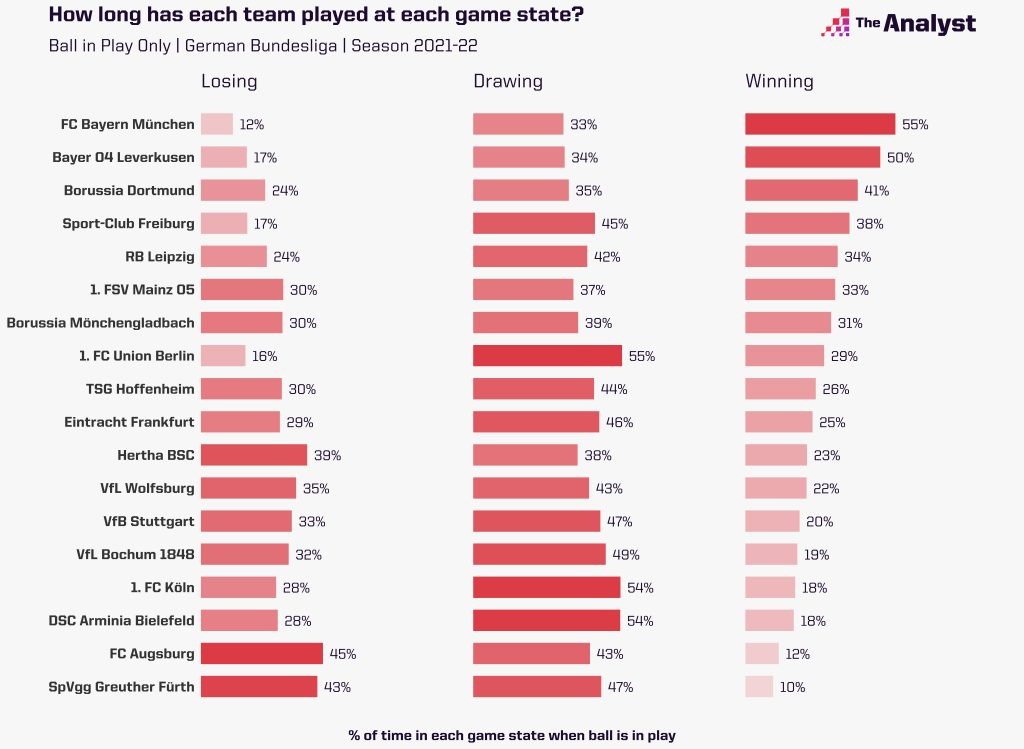
On average, Leverkusen’s opponents start their sequences 43.9m from their own goal, which is the second-highest figure in the league (Hertha 45.7m). This leaves space in behind for Leverkusen to launch killer counter attacks. So far this season they have fired a staggering 31 shots from fast breaks, at least 13 more than the next best Bundesliga team (Bayern 18). Across all of last season, no team managed more than 24 shots from fast breaks.
Seoane’s approach has seen Leverkusen score 49 goals in their first 20 BL matches this season – a new club record at this stage of a campaign and just four strikes shy of their tally from the entire 2020-21 season.
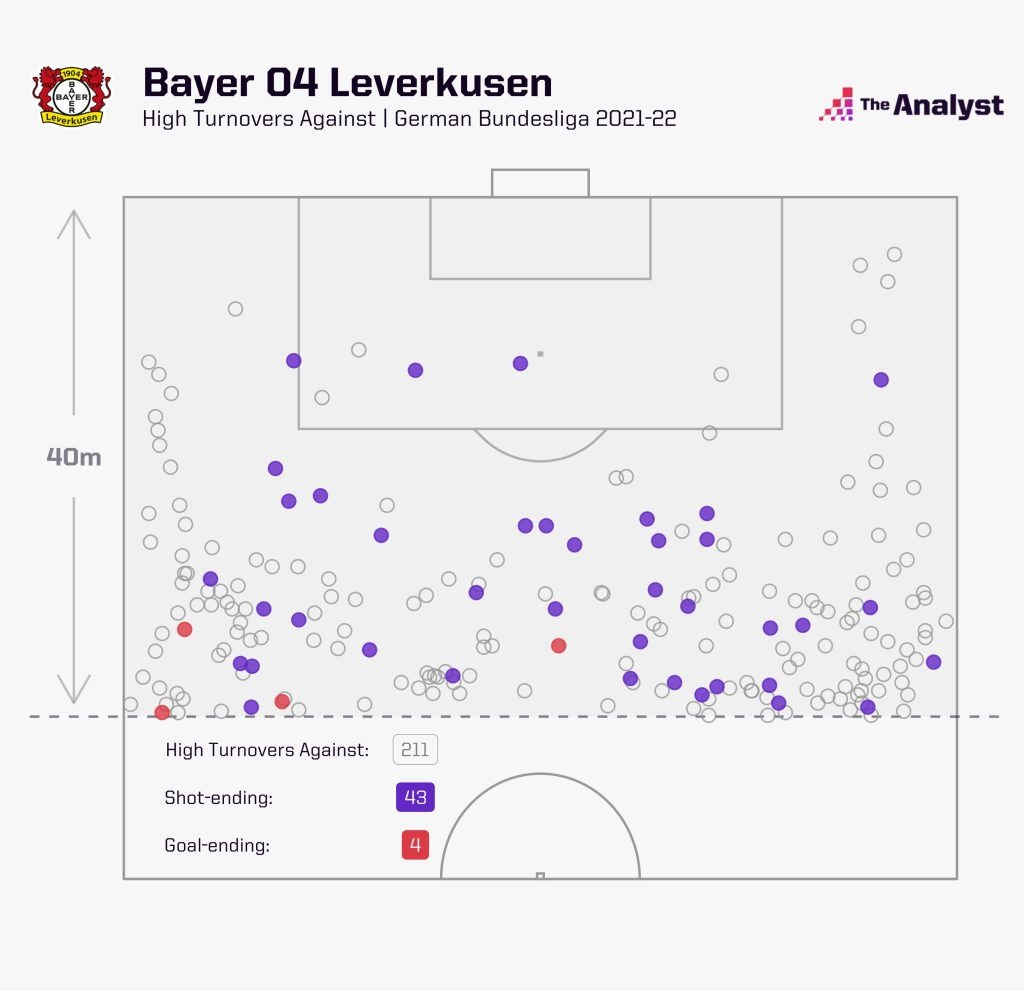
There is of course a risky element to this playing style too. Leverkusen have suffered the second most high turnovers in the top-flight this season (211 – Hertha 212), with the Werkself conceding a league-high 43 shots after such situations. After all, Leverkusen have dropped 12 points from winning positions in 2021-22, squandering two-goal leads on three different occasions this season (D2 L1) – once more than in the four previous campaigns combined.
Enjoy this? Subscribe to our mailing list to receive exclusive weekly content.
The post Bundesliga: How Does Each Team Play? appeared first on The Analyst.
[ad_2]
Read Entire Article

